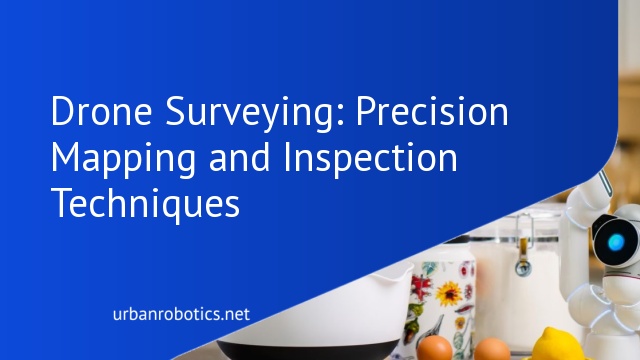In the remarkable arena of technological advancement, we’ve witnessed the transformative shift from traditional methods of drone surveying to more robust and precise techniques, including the use of drone technology.
Unmanned aerial vehicles (UAVs), commonly known as drones, equipped with advanced sensing technologies, have revolutionized the process of data collection and analysis in various industries.
This exemplary transformation is redefining the concept of mapping and inspection techniques and offering a whole new prospect for the future. Continuous innovation in drone technology is setting new milestones in capturing high-accuracy data, aiding in efficient decision-making and driving progress in various projects.
Drone surveying is a rapidly evolving technique, becoming a standard tool for surveying and GIS applications. These unmanned machines, equipped with cutting-edge RGB sensors, high-resolution cameras, and advanced LiDAR payloads, are used for capturing highly accurate data.
The field of drone surveying includes applications such as precision mapping, infrastructure inspection, land surveying, agriculture monitoring, and more. The operation of drones ranges from full-automatic operation to highly sophisticated control systems, achieving remarkable accuracy.
Moreover, solutions like Flightsurv and drone mapping software such as photogrammetry software enable professionals to visualize and analyze the collected geospatial data in a more precise and detailed manner, leading to more accurate decision-making.
The cost of drone surveying is predominantly decreasing and becoming more accessible for various industries, including construction, mining, agriculture, and research and environment.
Drones provide a cost-effective and time-saving solution compared to traditional surveying methods, with their ability to cover larger areas in less time and perform tasks such as data collection and monitoring more efficiently. Now, industries can get more profound insights into their projects through the rich, high-resolution imagery these drones provide.
Benefits of Drone Surveying
The invention and rapid adaptation of drone technology have unlocked several benefits that surpass the capabilities of traditional surveying methods. These benefits assert the supremacy of drone technology in performing efficient and high-accuracy surveying tasks:
- Data Accuracy: Drones equipped with advanced sensors and high-resolution cameras produce highly accurate data, enhancing the data-quality in various mapping projects. The use of techniques like RTK (Real-Time Kinematics) and PPK (Post Processed Kinematics) technology further improves the accuracy by providing highly accurate positions, which are pivotal in creating precise maps and constructs.
- Efficiency and Speed: A significant advantage of using drones for surveying tasks is time-saving. Drones can cover large areas more rapidly than manual surveys, thus significantly reducing the time it takes to gather geospatial data. They can handle various projects, from mapping large areas to inspecting infrastructure and monitoring environmental changes, with maximum efficiency.
- Cost-effectiveness: Implementing drone surveying drastically reduces the survey costs compared to traditional surveying methods. Reduced personnel requirements, shorter data collection time, and less need for expensive equipment constitute the cost reduction achieved by drone surveys.
- Safety and Accessibility: Drones provide a safer alternative to manual surveys, significantly reducing the need for personnel to work in harsh environments or inaccessible areas. UAVs can be deployed in a broad range of conditions, even in areas with difficult topography or hazardous conditions, without compromising the safety of the surveying team.
- Versatility: Drones offer exceptional versatility, being capable of carrying a range of instruments such as RGB cameras, multi-spectral cameras, and LiDAR payloads. This versatility allows them to be used for a wide variety of surveying applications, from agricultural health monitoring to geological hazard monitoring.
The integration of drone technology is not limited to mere data capture; it extends to accurate data analysis and interpretation, which provides intelligence to enable informed decision-making.
It is this valuable insight, driven by extensive aerial data, that is enabling industries like construction, agriculture, and surveying to push the boundaries of their capabilities.
Applications of Drone Surveying
The proliferation of drone technology has opened up a broad spectrum of applications across various industries. The vertical take-off and landing capabilities coupled with endurance and efficiency have pushed the envelope for drones usage beyond recreational purposes. Here are key applications where drone technology has a significant impact:
- Land surveying: Drones provide a modern approach to land surveying by capturing aerial data with exceptional detail and accuracy. They offer an effective solution to create 2D maps and 3D models with a high level of detail, which aids in road construction surveying, urban planning, and precise topographic mapping.
- Agriculture Monitoring: Advanced sensors and multi-spectral cameras aid in agriculture monitoring by capturing data related to crop health, pest infestation, irrigation issues, and soil quality. Drones can inspect crop fields in less time, providing farmers with substantial data to boost crop productivity and overall yield.
- Infrastructure Inspection: Infrastructure such as power grids, buildings, dams, and bridges can be effectively inspected using drones. Precise inspection of these structures is made possible by high-precision imaging capabilities, enabling the detection of minor changes, vulnerabilities, or damages.
- Mining Mapping: Aerial mapping in the mining industry increases safety by eliminating the need for manual, ground-based surveys. Using drones, miners can carry out pit and dump monitoring, inventory management, and haul road optimization with high accuracy.
- Research and Environment: Drones can access harsh and remote environments without posing any risk to humans. They’ve become an essential tool for monitoring wildlife, tracking deforestation, assessing geological hazards, and supporting overall environmental research.
Technologies and Equipment for Drone Surveying
The success of drone surveying depends largely on the integration of the latest technologies and sophisticated equipment. Sophisticated UAVs like the WingtraOne, with its VTOL capabilities and high flight speed, offer a fusion of robust performance and precision. Here’s an overview of the essential technologies and equipment:
- Advanced Cameras and Sensors: Drones equipped with RGB cameras, multi-spectral cameras, or LiDAR payloads play a crucial role in collecting high-resolution and high-precision data. These sensors capture data across different spectrums, enabling detailed analysis and observations.
- RTK and PPK technology: RTK (Real-Time Kinematic) and PPK (Post Processing Kinematics) are advanced positioning techniques that allow drones to achieve absolute accuracy down to a centimeter. They improve the reliability of flight paths and the precision of geographic data.
- Drone Mapping Software: Software solutions like photogrammetry software process the collected data and generate 2D maps or 3D models. They allow professionals to stitch aerial imagery together to create detailed orthomosaic maps.
- Data Analysis Tools: Once the data collection is completed, tools such as Flightsurv aid in more in-depth insights into the collected data. They accelerate interpretation and facilitate effective decision-making.
Drone Surveying Advantages
As a transformative technology, drone surveying offers numerous advantages for unprecedented precision mapping and inspection techniques.
By providing accurate, high-resolution, and detailed data, drone surveying significantly reduces fieldwork time and cuts down survey costs, all while enhancing safety.
These unmanned aerial vehicles pave the path for a new era of productivity enhancements – enabling businesses to generate site-wide data, analyze it in real-time, and secure unparalleled insights into their operations.
Mapping and monitoring tasks have done a paradigm shift, primarily due to the advent and advancements in drone technology.
The efficiency, safety, and cost-effectiveness that drones bring to the platform stand as a testament to their potential, making drone surveying a game changer in industries that depend upon the delivery of accurate geospatial data.
The future of drone surveying stands bright – with the continuous advancements in technology, we can expect more innovative and powerful applications in the years to come.





